Cell preparation
In this work (1) SK-BR-3 (ATCC, Virginia, USA, HTB-30), HT-29 (ATCC, Virginia, USA), and CAKI-2 cells were thawed and cultured for two weeks in McCoy’s 5A (modified) Media (Wisent Inc., Quebec, Canada, 317-010-CL) supplemented with 10% fetal bovine serum (FBS), and 1% penicillin/streptomycin, (2) OCI-AML-5 cells (DSMZ, Braunschweig, Germany, ACC247) were thawed and cultured for two weeks in Alpha modified Eagle medium (Wisent Inc., Quebec, Canada, 310-010-CL) containing 10% FBS and 1% penicillin-streptomycin (Wisent Inc., Quebec, Canada, 450-201-EL) by volume, and (3) MCF-10A cells MCF-10A cells (Addex Bio, California, USA, C0006015) were thawed and cultured for three weeks in 1:1 Dulbecco’s Modified Essential Media and F12 media (ThermoFisher, Massachusetts, USA, 11330032), supplemented with 5% Horse serum (Sigma-Aldrich, Ontario, Canada, H1270), 20 ng/mL EGF (Peprotech, New Jersey, USA, AF-100-15), 0.5 ug/mL Hydrocortisone (Sigma-Aldrich, Ontario, Canada, H0888), 100 ng/mL Cholera Toxin (List Biological Laboratories, California, USA, 100B), …
• Product #100B – Cholera Toxin (AZIDE-FREE) from Vibrio cholerae



